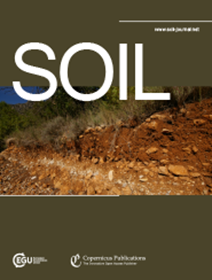Using Monte Carlo conformal prediction to evaluate the uncertainty of deep-learning soil spectral models
IF 4.3
2区 农林科学
Q1 SOIL SCIENCE
引用次数: 0
Abstract
Abstract. Uncertainty quantification is a crucial step in the practical application of soil spectral models, particularly in supporting real-world decision making and risk assessment. While machine learning has made remarkable strides in predicting various physiochemical properties of soils using spectroscopy, its practical utility in decision making remains limited without quantified uncertainty. Despite its importance, uncertainty quantification is rarely incorporated into soil spectral models, with existing methods facing significant limitations. Existing methods are either computationally demanding, fail to achieve the desired coverage of observed data, or struggle to handle out-of-domain uncertainty. This study introduces an innovative application of Monte Carlo conformal prediction (MC-CP) to quantify uncertainty in deep-learning models for predicting clay content from mid-infrared spectroscopy. We compared MC-CP with two established methods: (1) Monte Carlo dropout and (2) conformal prediction. Monte Carlo dropout generates prediction intervals for each sample and can address larger uncertainties associated with out-of-domain data. Conformal prediction, on the other hand, guarantees ideal coverage of true values but generates unnecessarily wide prediction intervals, making it overly conservative for many practical applications. Using 39 177 samples from the mid-infrared spectral library of the Kellogg Soil Survey Laboratory to build convolutional neural networks, we found that Monte Carlo dropout itself falls short in achieving the desired coverage – its 90 % prediction intervals only covered the observed values in 74 % of the cases, well below the expected 90 % coverage. In contrast, MC-CP successfully combines the strengths of both methods. It achieved a prediction interval coverage probability of 91 %, closely matching the expected 90 % coverage and far surpassing the performance of the Monte Carlo dropout. Additionally, the mean prediction interval width for MC-CP was 9.05 %, narrower than the conformal prediction's 11.11 %. The success of MC-CP enhances the real-world applicability of soil spectral models, paving the way for their integration into large-scale machine learning models, such as soil inference systems, and further transforming decision making and risk assessment in soil science.用蒙特卡罗保形预测方法评价深度学习土壤光谱模型的不确定性
摘要。在土壤光谱模型的实际应用中,特别是在支持现实世界的决策和风险评估方面,不确定性量化是至关重要的一步。虽然机器学习在利用光谱预测土壤的各种理化性质方面取得了显着进步,但它在决策中的实际效用仍然有限,没有量化的不确定性。尽管不确定度量化很重要,但很少将其纳入土壤光谱模型,现有方法存在很大的局限性。现有的方法要么计算量大,要么无法实现观测数据的预期覆盖,要么难以处理域外的不确定性。本研究介绍了蒙特卡罗共形预测(MC-CP)的创新应用,以量化中红外光谱预测粘土含量的深度学习模型中的不确定性。我们将MC-CP与两种已建立的方法(1)Monte Carlo dropout和(2)适形预测进行了比较。蒙特卡罗dropout为每个样本生成预测区间,并且可以处理与域外数据相关的更大的不确定性。另一方面,保形预测保证了真值的理想覆盖,但产生了不必要的宽预测区间,使其在许多实际应用中过于保守。使用来自凯洛格土壤调查实验室中红外光谱库的39177个样本来构建卷积神经网络,我们发现蒙特卡罗dropout本身无法达到期望的覆盖率-其90%的预测区间仅覆盖了74%的情况下的观测值,远低于预期的90%覆盖率。相比之下,MC-CP成功地结合了两种方法的优势。它实现了91%的预测区间覆盖概率,与预期的90%覆盖率非常接近,远远超过了蒙特卡洛dropout的性能。MC-CP的平均预测区间宽度为9.05%,比适形预测的11.11%窄。MC-CP的成功增强了土壤光谱模型在现实世界中的适用性,为将其集成到土壤推理系统等大规模机器学习模型中铺平了道路,并进一步改变了土壤科学的决策和风险评估。
本文章由计算机程序翻译,如有差异,请以英文原文为准。
求助全文
约1分钟内获得全文
求助全文
来源期刊

Soil
Agricultural and Biological Sciences-Soil Science
CiteScore
10.80
自引率
2.90%
发文量
44
审稿时长
30 weeks
期刊介绍:
SOIL is an international scientific journal dedicated to the publication and discussion of high-quality research in the field of soil system sciences.
SOIL is at the interface between the atmosphere, lithosphere, hydrosphere, and biosphere. SOIL publishes scientific research that contributes to understanding the soil system and its interaction with humans and the entire Earth system. The scope of the journal includes all topics that fall within the study of soil science as a discipline, with an emphasis on studies that integrate soil science with other sciences (hydrology, agronomy, socio-economics, health sciences, atmospheric sciences, etc.).
 求助内容:
求助内容: 应助结果提醒方式:
应助结果提醒方式:


